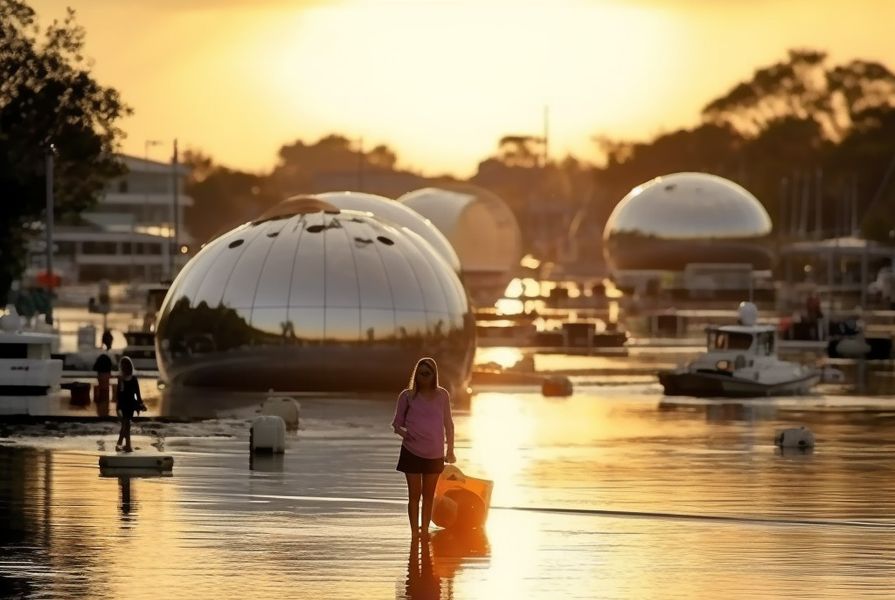Some 23 million years ago, the Tweed volcano erupted as part of a series of eruptions along the east coast of the continent we now know as Australia. Two thousand metres high and stretching from what is now Tamborine in the north to Lismore in the south, it dominated the landscape. After three million years, its volcanic activity ceased. The region’s high rainfall carved rivers into its landscapes, draining water east to the ocean. These rivers and their tributaries form part of the region on the far north coast of New South Wales that we refer to as the Northern Rivers.
The Northern Rivers region is much loved. The soils are fertile and combined with the subtropical climate, support environments that are internationally significant in terms of biodiversity. These environments, which have supported people for thousands of years, are rich in meaning in many different ways to many different communities: they embody Indigenous creation stories, cultural landscapes and vital resources.
Flooding is embedded into the history of Lismore, a town that rests at the junction of Wilsons River and Leycester Creek. Residents refer to the events of 1954 and 1974 with reverence. The 2017 flood reached almost the same height. But in February 2022, Lismore experienced a flood more than two metres higher than any previously recorded, confronting Northern Rivers residents and prompting them to rethink what might be possible when big rains come.
Lismore Encore curators Sandra Kaji-O’Grady and Kezia Geddes, who both have personal experience of the flood damage, wanted to “make room for a cultural contribution to the town’s recovery.” They asked architects and artists to explore “fictional futures” for Lismore. Given the many non-fictional futures that the town and the region are facing as they try to recover from the 2022 event, the idea of fictional futures felt a little awkward and I was keen to see what the exhibition could bring to the discussion. It produced a series of ideas in relation to the town’s flood resilience – some focusing on minor architectural additions, and others suggesting major infrastructure to remove Lismore from flood risk. Some exhibitors had spent time in the town post-flood and had a detailed understanding of the conditions, while others had to imagine the place from maps and photos. But all, says Kaji-O’Grady, contributed “in a way that was empathetic to the townspeople.”
An association of ‘unviable towns’ by Sophie Canaris and Oskar Johanson grounds the exhibition well. Its map, postcards from places at climate risk and associated video are sobering and extremely effective in establishing that Lismore is not alone in the questions locals are asking themselves: The future is here. Should I stay or should I go?
Woha Futures considers the spaces left behind, should Lismore retreat from the flood plain. In a heavy-handed approach to future-proofing the town against inundation, City above the Floods risks alienating it from the nature of the place that has harboured generations of people. Brandon Pais, a master of architecture student in Sydney, offers a more considered approach, inserting a City of Towers to assist in living with flooding.
Lisark and Furnark by Moon Hoon.
Image: Courtesy of Moon Hoon.
There are floating futures, too. US-based artist Virginia San Fratello imagines six “dirigibles” (a new building typology that is “simultaneously boat, building and airship”), while Moon Hoon proposes Lisark and Furnark (installations that can be occupied as escape pods during an emergency). In his artist’s statement, Hoon – who is based in South Korea but lived in Tasmania as a teenager – gives a pep talk, of sorts: “We shall not give ourselves into tragedies; they shall become inspiring sparks for our resilient, playful, innovative, creative transformism.” These ideas of refuge have good intentions, but the hero shots in flooded environments risk glamorizing the objects.
Lismore artists Chas Glover and Kate Stroud bring greater insight. Their observations speak of the city, the dilemmas of living on the flood plain, and the humour needed to cope. Strouds’ Did you notice?, a community noticeboard representing a collection of locals’ experiences at a future date, was the highlight of the show. (If you’re not eligible or at risk, you’re instructed to “colour wherever you want” in the Resilient Homes Program Colouring-in Competition.)
If you wander Lismore’s streets, you’ll see the high-water marks from 2022 on second-storey windows, including at the Lismore Regional Gallery. The Gollan Hotel, home to many shared stories, sits quiet and empty. Shops in the CBD are gradually coming back to life, while others are preparing to be reoccupied. We’ve reached a time where we need to think differently. The exhibition curators wanted to prompt viewers to ask questions about the long-term future for Lismore – “even while the town is preoccupied with recovery and the fractured politics of residential buybacks.”
I can’t help wondering what ideas would emerge if we changed the question from “How do we cope with flooding?” to “What relationship would we like to have with these waters?” The Government Architect New South Wales recently released its Connecting with Country Framework, suggesting that the “health and wellbeing of Country will help to reduce impacts of natural events such as fire, drought and flooding through sustainable ways of using land and water.”1 Now is the time for our colonial settlements to listen to Country, to care for its health and wellbeing.
Communities have shown unbelievable resilience and collective strength during the recent flood. But with every heavy downpour, residents are on edge. Despite their love for the Northern Rivers, many are beginning to wonder whether they can live with the strain of increasingly regular flooding events.
It’s time to reassess our relationship with our rivers. After the 1954 floods, several towns – including Lismore – built levee walls to protect themselves, but these walls were not high enough to stop the 2022 flood. Do we continue to build walls higher and higher, further dislocating ourselves from the rivers? Or do we let the rivers flood and learn how to dwell around them? Lismore Encore contributes to a broader discussion we need to have about how we live on flood plains and relate to rivers and waterways. Only once we understand this relationship can we respond appropriately with our built environments.
1. Government Architect New South Wales, Connecting with Country, governmentarchitect.nsw.gov.au/projects/designing-with-country (accessed 15 August 2023).
Lismore Encore was on display at the Lismore Regional Gallery from 20 July until 19 August 2023.




















